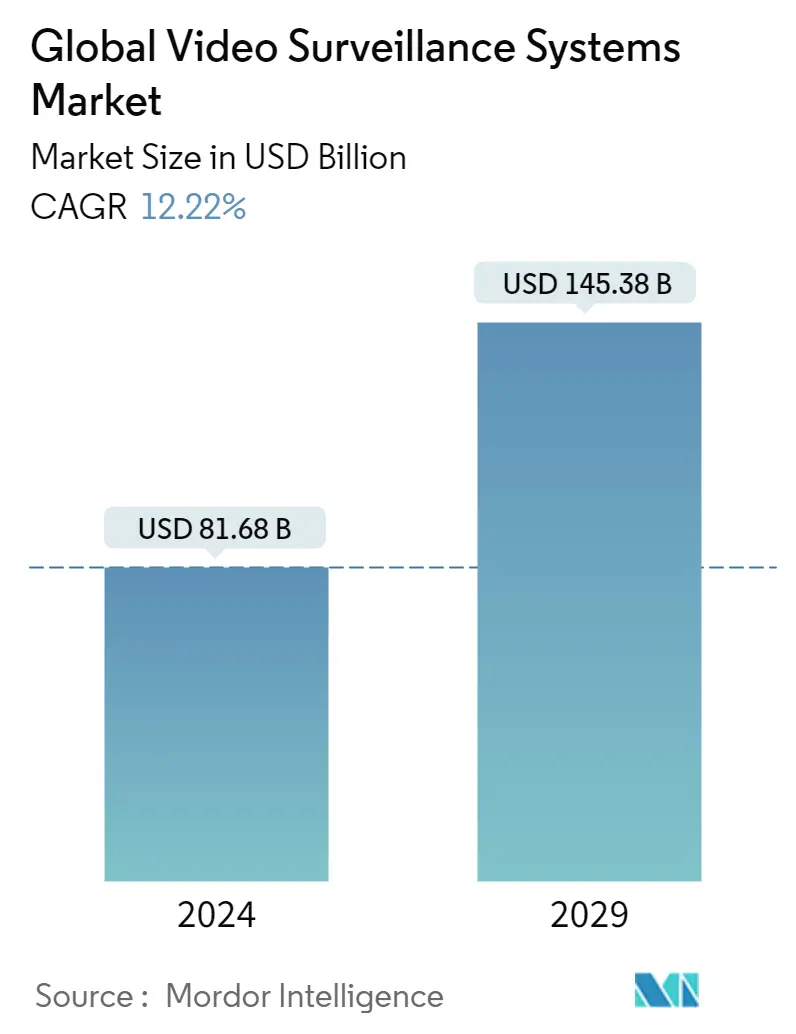Market Size of Global Video Surveillance Systems Industry

| Study Period | 2019 - 2029 |
| Market Size (2024) | USD 81.68 Billion |
| Market Size (2029) | USD 145.38 Billion |
| CAGR (2024 - 2029) | 12.22 % |
| Fastest Growing Market | Asia Pacific |
| Largest Market | North America |
Major Players
*Disclaimer: Major Players sorted in no particular order |
Video Surveillance Systems Market Analysis
The Global Video Surveillance Systems Market size is estimated at USD 81.68 billion in 2024, and is expected to reach USD 145.38 billion by 2029, growing at a CAGR of 12.22% during the forecast period (2024-2029).
Introducing new IP-based digital technologies to detect and prevent undesirable behaviors such as shoplifting, theft, vandalism, and terror attacks are expected to fuel the growth of the video surveillance market. Video surveillance is used in various industries, including manufacturing, banking, financial services, transportation, and retail. These methods are incorporated in nations such as the United States, the United Kingdom, India, China, and Brazil, owing mostly to the bigger scale of the concerned industries and more consumer awareness.
- T he use of video analytics and video surveillance cameras to recognize potential offenders is anticipated to help decrease crime rates in various countries. This is also expected to increase demand for an integrated surveillance system.
- In terms of adoption, VSaaS has significantly improved in recent years. This is primarily due to IP camera sales market penetration. Significant factors such as IT cost containment by major IT organizations, the emergence of data centers, and improved functionalities associated with centralized data are assisting in the growth of the VSaaS segment.
- During the COVID-19 pandemic, IP video surveillance is used primarily for various security purposes across multiple countries. These next-generation cameras feature high-performance computing power and video analytics, allowing users to transform real-time images into big data analysis. Several video analytic techniques, such as queue management, people counting, crowd detection, and personal protective equipment, have been commonly used to take precautionary measures under social distancing practices and norms.
- Furthermore, high investments in security and safety solutions by countries such as India and China aided the Asia-Pacific region in capturing the largest market share. Public safety has emerged as a critical function for governments throughout the region. As cities continue to grow, video surveillance becomes an increasingly important tool for monitoring population movement and combating crime.
- The emergence of the COVID-19 pandemic raised its usage to newer heights to limit exposure to the virus. National infrastructure, such as hospitals, monitors patient vital signs remotely through in-room video cameras and integrated telemetry systems, significantly reducing the frequency of in-person encounters between patients and medical staff.
- However, these video surveillance systems have been condemned as a violation of privacy and are opposed by a number of civil liberties organizations and activists. People are increasingly concerned about who watches the video and how it might be abused because they expect their personal information to be used only for legitimate and specific purposes.
Video Surveillance Systems Industry Segmentation
Video surveillance systems contain one or more video cameras connected to a network that sends the captured video or audio data to a specific location. The captured images are monitored in real-time or sent to a central location for recording and storage. Many applications, such as crime prevention, industrial process monitoring, and traffic management, are increasingly utilizing video surveillance systems.
The Global Video Surveillance Systems Market is segmented by Type (Hardware (Camera (Analog, IP Cameras, Hybrid), Storage), Software (Video Analytics, Video Management Software), Services (VSaaS)), by End-user Vertical (Commercial, Infrastructure, Institutional, Industrial, Defense, Residential), and Geography.
| By Type | ||||||||
| ||||||||
| ||||||||
| Services (VSaaS) |
| By End-user Vertical | |
| Commercial | |
| Infrastructure | |
| Institutional | |
| Industrial | |
| Defense | |
| Residential |
| By Geography | ||||||
| ||||||
| ||||||
| ||||||
| ||||||
|
Global Video Surveillance Systems Market Size Summary
The global video surveillance market is poised for significant growth, driven by the adoption of IP-based digital technologies aimed at enhancing security across various sectors such as manufacturing, banking, transportation, and retail. The integration of video analytics and surveillance systems is expected to play a crucial role in crime reduction and the demand for comprehensive surveillance solutions. The market's expansion is further supported by the increasing penetration of Video Surveillance as a Service (VSaaS), facilitated by advancements in IP camera technology and centralized data management. The COVID-19 pandemic has also accelerated the use of video surveillance for security and health monitoring purposes, with next-generation cameras offering advanced analytics capabilities to support social distancing measures.
In the Asia-Pacific region, countries like China and India are leading the charge in video surveillance adoption, driven by high investments in security solutions and the implementation of smart city initiatives. China's integration of advanced surveillance systems within urban infrastructure, such as the Hangzhou "City Brain" project, exemplifies the growing trend towards smart city development. The market is characterized by intense competition among key players like Honeywell, Bosch, and Panasonic, who are continuously innovating to maintain a competitive edge. Despite the market's growth, concerns regarding privacy and the potential misuse of surveillance data remain significant, prompting ongoing debates about the ethical implications of widespread surveillance.
Global Video Surveillance Systems Market Size - Table of Contents
-
1. MARKET INSIGHTS
-
1.1 Market Overview
-
1.2 Industry Attractiveness - Porter's Five Forces Analysis
-
1.2.1 Threat of New Entrants
-
1.2.2 Bargaining Power of Buyers
-
1.2.3 Bargaining Power of Suppliers
-
1.2.4 Threat of Substitute Products
-
1.2.5 Intensity of Competitive Rivalry
-
-
1.3 Industry Value Chain Analysis
-
1.4 Technology Snapshot
-
1.5 Impact of COVID-19 on the Market
-
-
2. MARKET SEGMENTATION
-
2.1 By Type
-
2.1.1 Hardware
-
2.1.1.1 Camera
-
2.1.1.1.1 Analog
-
2.1.1.1.2 IP Cameras
-
2.1.1.1.3 Hybrid
-
-
2.1.1.2 Storage
-
-
2.1.2 Software
-
2.1.2.1 Video Analytics
-
2.1.2.2 Video Management Software
-
-
2.1.3 Services (VSaaS)
-
-
2.2 By End-user Vertical
-
2.2.1 Commercial
-
2.2.2 Infrastructure
-
2.2.3 Institutional
-
2.2.4 Industrial
-
2.2.5 Defense
-
2.2.6 Residential
-
-
2.3 By Geography
-
2.3.1 North America
-
2.3.1.1 United States
-
2.3.1.2 Canada
-
-
2.3.2 Europe
-
2.3.2.1 Germany
-
2.3.2.2 United Kingdom
-
2.3.2.3 France
-
2.3.2.4 Rest of Europe
-
-
2.3.3 Asia Pacific
-
2.3.3.1 China
-
2.3.3.2 Japan
-
2.3.3.3 India
-
2.3.3.4 Rest of Asia Pacific
-
-
2.3.4 Latin America
-
2.3.4.1 Brazil
-
2.3.4.2 Mexico
-
2.3.4.3 Rest of Latin America
-
-
2.3.5 Middle East and Africa
-
2.3.5.1 United Arab Emirates
-
2.3.5.2 Saudi Arabia
-
2.3.5.3 Rest of Middle East and Africa
-
-
-
Global Video Surveillance Systems Market Size FAQs
How big is the Global Video Surveillance Systems Market?
The Global Video Surveillance Systems Market size is expected to reach USD 81.68 billion in 2024 and grow at a CAGR of 12.22% to reach USD 145.38 billion by 2029.
What is the current Global Video Surveillance Systems Market size?
In 2024, the Global Video Surveillance Systems Market size is expected to reach USD 81.68 billion.

